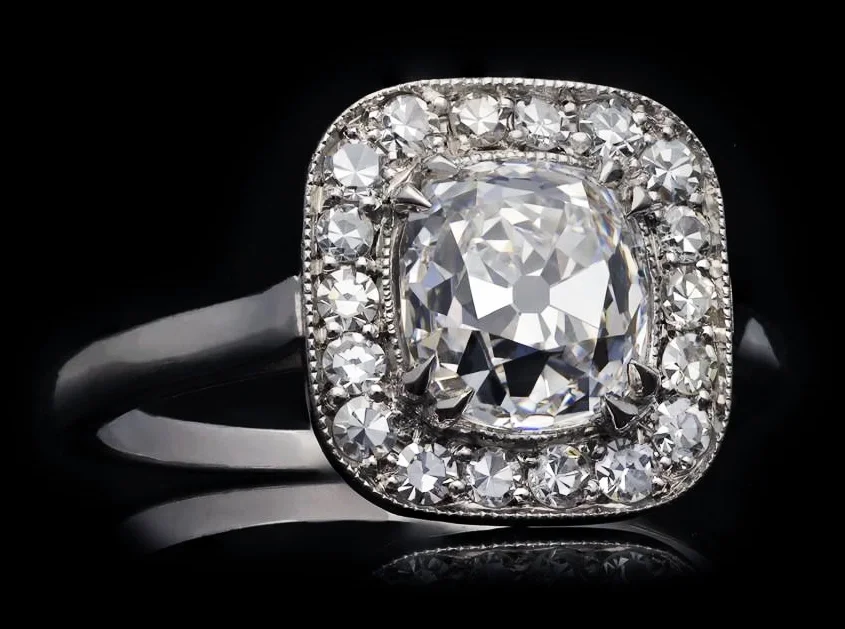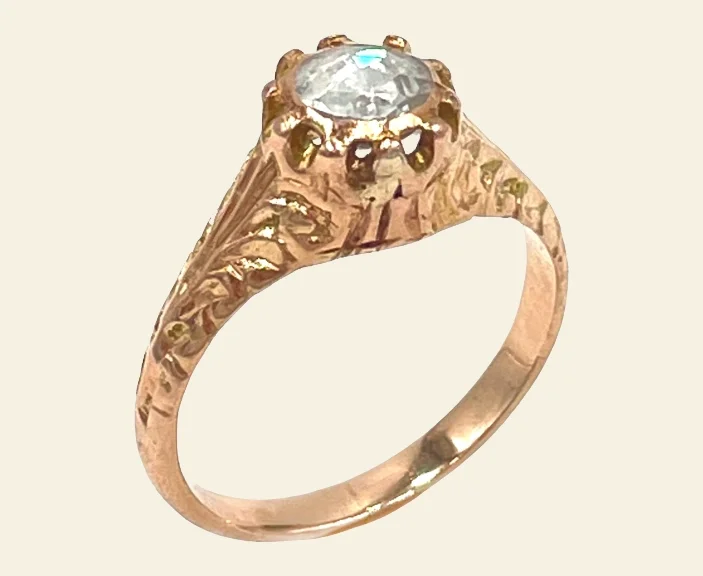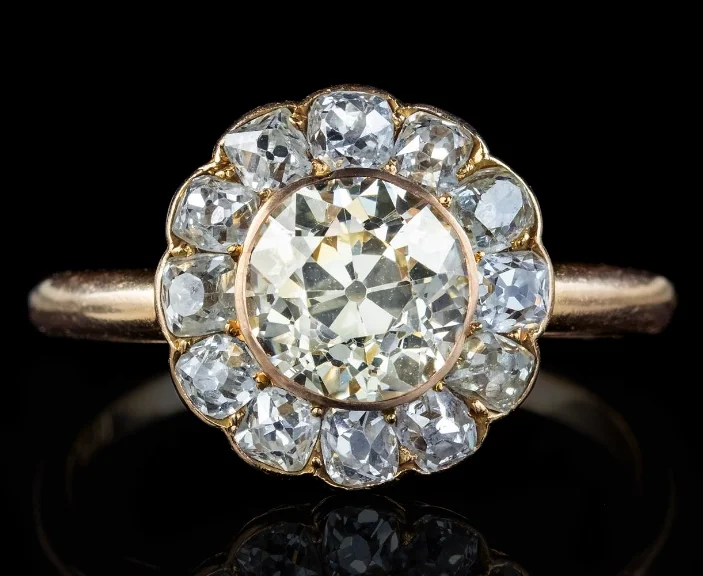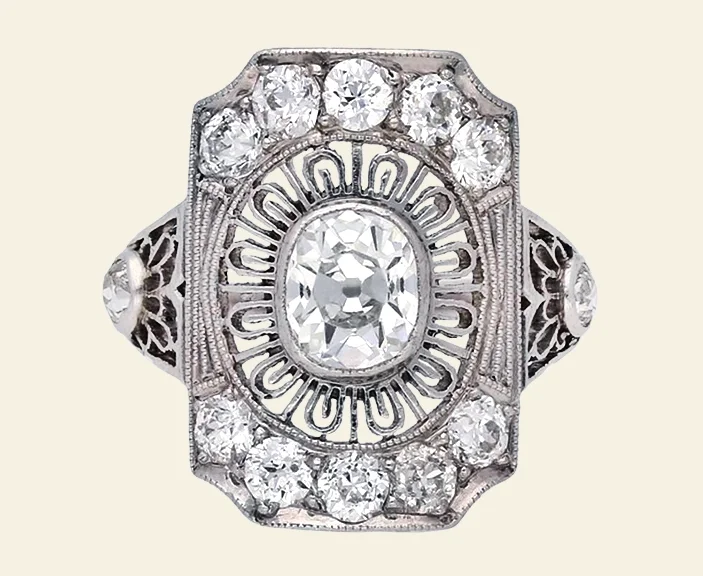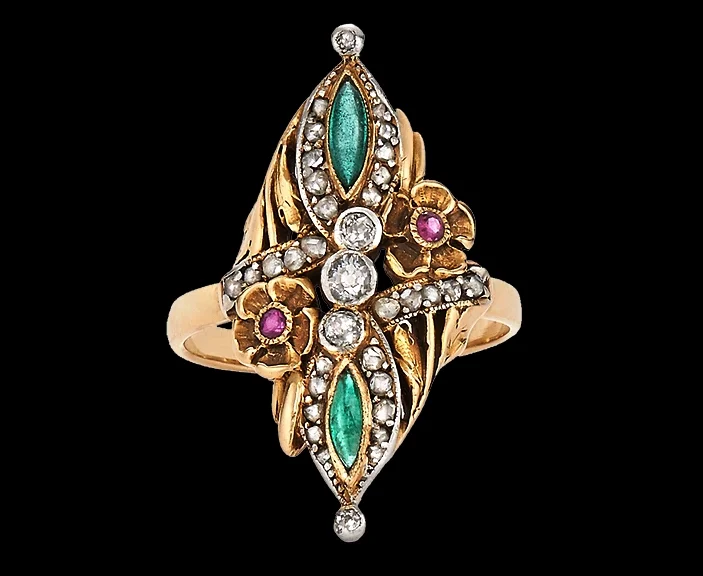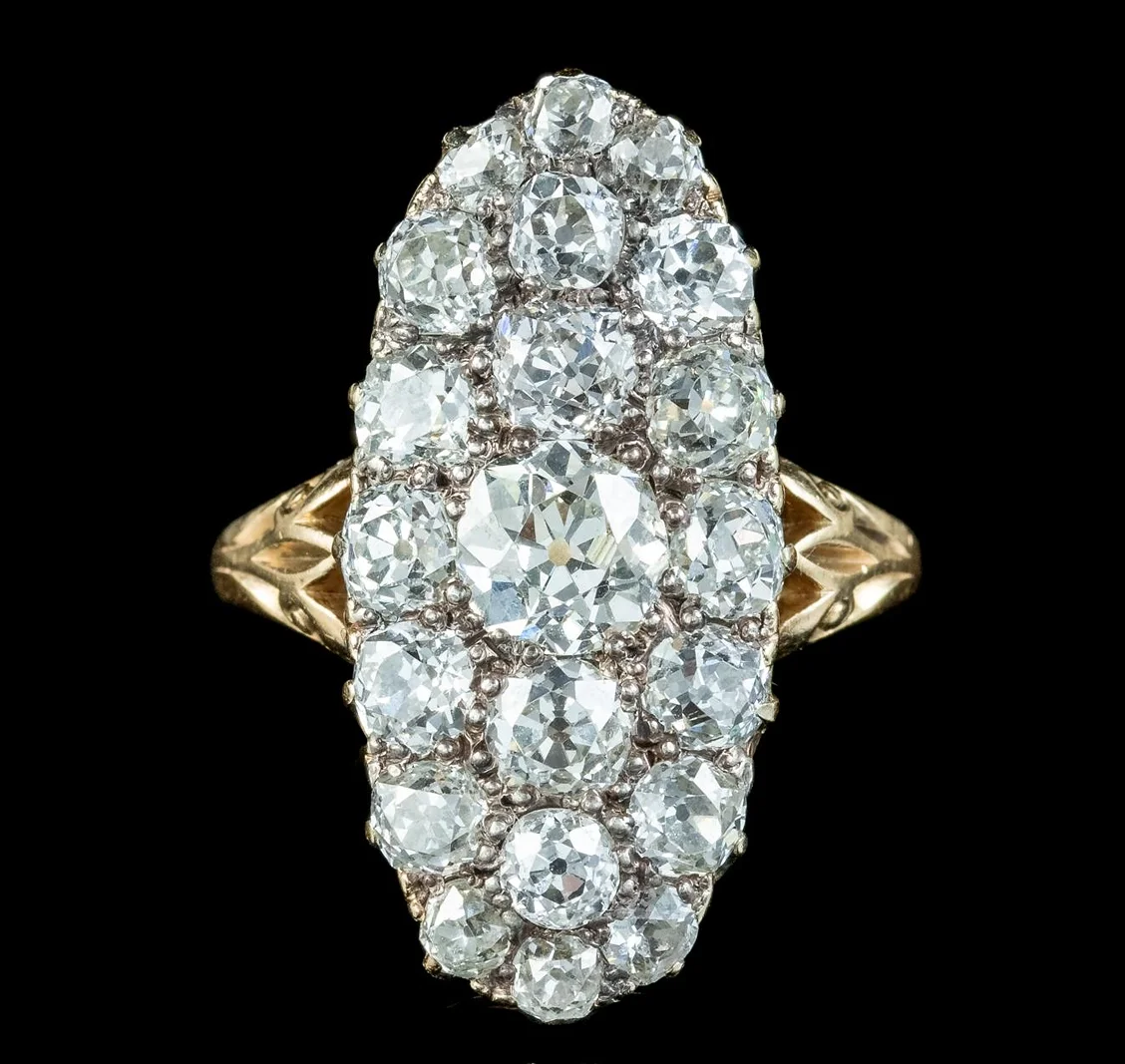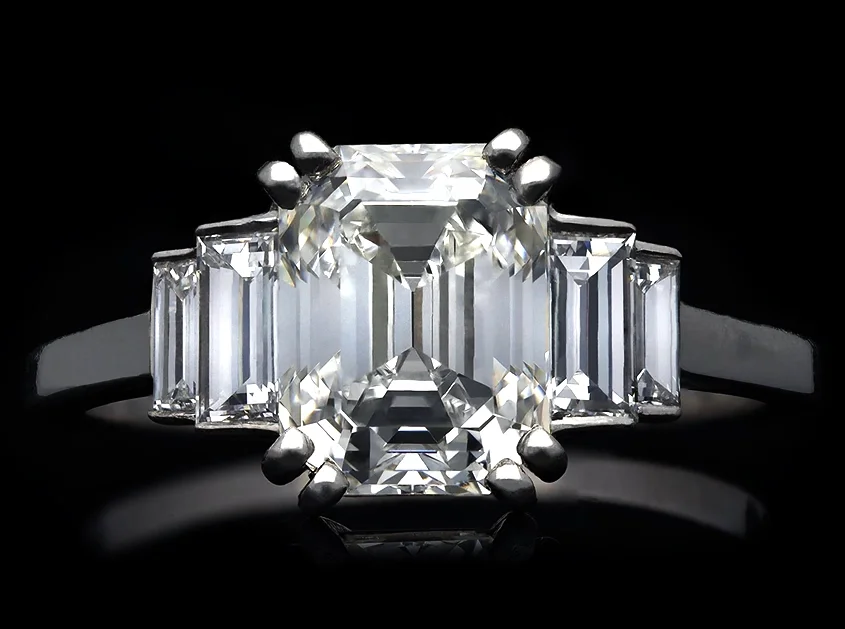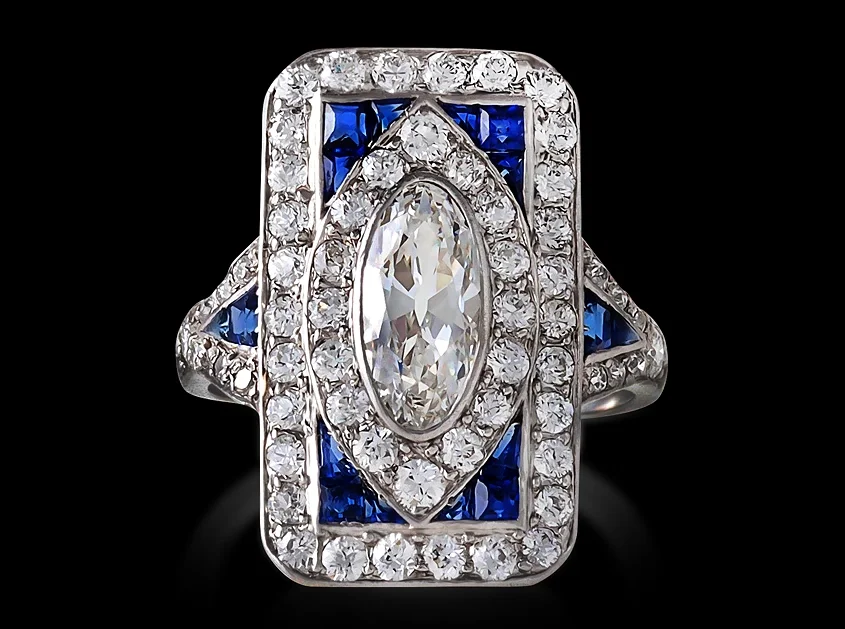The 1stDibs Antique Engagement Rings Buying Guide
An antique engagement ring is a unique symbol of love that transcends time. Knowing where to buy an antique engagement ring — and what to look for — is easy with the right guidance. Here, we explore why antique engagement rings are having a comeback and share everything you need to know when choosing one of these classic pieces.
History and Symbolism
Antique engagement rings are storied and rich in provenance. Their romantic history encompasses the era when they are made, the individuals who wore them and the unique particulars of craftsmanship, from classic settings to one-of-a-kind designs.
Proposing with an antique engagement ring grants you the opportunity to share the dreams and artisanry of another time with your beloved. The character of antique jewels reflects the values and customs of the century in which they were made. Shaped by the hands of highly skilled artisans, these unique engagement rings showcase the vision and techniques of days gone by. Rare and precious gemstones are featured in settings and cuts that are no longer readily available. Antique engagement rings represent love that has both a legacy and a future.
Origins and Evolution
Rings have held deep meaning for centuries. In ancient Egypt, women wore rings made from reed or hemp as symbols of eternity and belonging. Rings made from copper, ivory or iron were symbolic of pledged love and loyalty in ancient Rome.
It wasn’t until 1477 that a ring signified engagement. That year, Archduke Maximilian of Austria proposed to his bride, Mary of Burgundy, with a diamond engagement ring. The design commissioned by the archduke had a special M-shaped stone setting for “Mary.” It was the world’s first engagement ring and broke ground for modern engagement rituals. Today, antique engagement rings carry this history forward, conveying commitment through precious stones and fine workmanship.
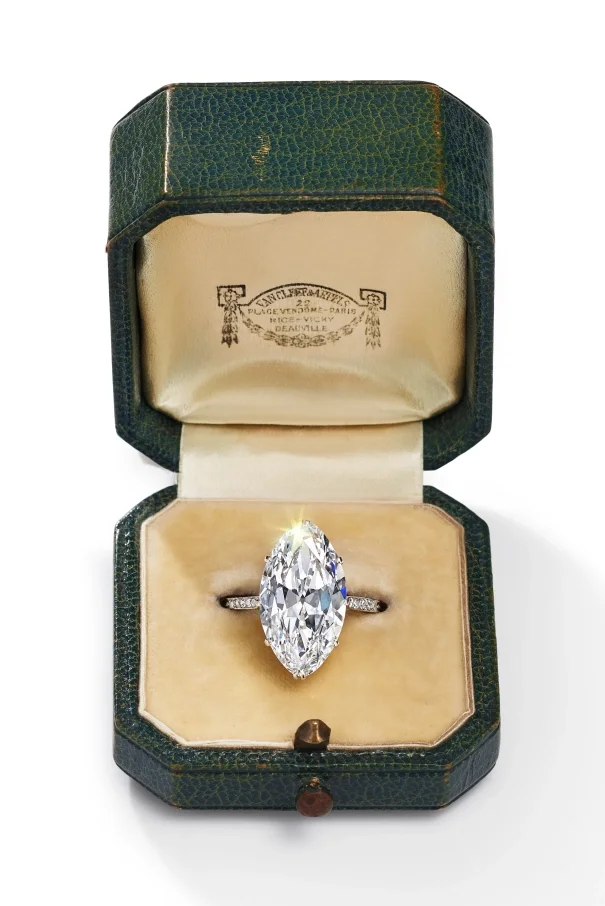
A 1920s Art Deco Van Cleef & Arpels diamond ring. Offered by Siegelson.
Periods and Styles of Antique Engagement Rings
From century to century, every period develops its own captivating art with its own singular influences and designs that make jewelry from that era instantly recognizable. Distinct motifs, the choice of metals and selection of precious or semiprecious gemstones all shape and define the full range of antique engagement rings. Each one is a glimpse into the artistic, cultural and social aspects of these different periods.
A Georgian solitaire engagement ring from the early 1800s features intricate designs along the band. Offered by Massoyan Jewelers.
Georgian Era, 1714–1837
Georgian-era engagement rings showcase artisanal European craftsmanship. Pieces from the 18th and early 19th centuries were always handmade and reflect close attention to detail.
The design of Georgian jewelry was traditionally feminine, often incorporating flowers, foliage and plumes. Pearls, along with a range of colored gemstones, were widely used. Showy engravings on precious metals are hallmarks of Georgian jewelry and capture the essence of the era.
Diamonds were in high demand but scarce during this period and, as a result, not as frequently used as they would be in later centuries. The rubies, sapphires, emeralds, pearls and rare diamonds in Georgian rings were often placed in closed-back settings in ornate designs crafted from silver, gold, steel, iron or pinchbeck, a blend of copper and zinc.
A Victorian 18-karat yellow-gold antique engagement ring with an old mine-cut diamond as its center stone, surrounded by smaller diamonds in the period’s popular flower arrangement. Offered by Heritage Antique Jewellery.
Victorian Era, 1837–1901
The earliest period of the Victorian era, which historians often call the Romantic period, marks Prince Albert’s engagement to Queen Victoria. Romantic notions of love are reflected in the period’s designs, which showcase rubies, amethysts and emeralds in motifs featuring hearts and flowers. The tradition of bestowing engagement and wedding rings became widely popular at this time, and Victorian engagement rings were initially made only of gold. The pieces involved intricate filigrees and engravings of symbols of eternal love, from snakes to hearts.
During the Victorian era’s Grand Period, diamonds became more accessible and affordable with the 1867 discovery of diamond mines in South Africa. Diamonds moved into a position of gleaming prominence on many engagement rings, leading to the wide range of antique solitaire engagement rings available from this period. In the late 19th century, esteemed American luxury jeweler Tiffany & Co. introduced its solitaire diamond design, which remains among its most popular styles of engagement ring. The Tiffany six-prong setting raises the stone above the band, allowing its facets to catch the light and reflect it through the stone.
Colored gemstones, often framing a diamond, continued to be popular choices for engagement rings in the 19th century. Set in claw-like prong settings made from metals like gold, steel, aluminum and pinchbeck, gemstones were arranged in opulent clusters, often in the shape of a flower or in the “Toi et Moi” style.
Romantic Toi et Moi rings first became famous in 1796, when Napoleon Bonaparte presented Joséphine with a pear-shaped diamond and sapphire piece. Another enchanting trend of the period involved acrostics, in which the first letter of each gemstone was used to spell a secret message, such as regard, adore, dear or dearest.
An Edwardian platinum antique engagement ring features an antique cushion cut diamond. Offered by Berganza.
Edwardian Era, 1901–15
The Edwardian era is part of the Belle Époque, which lasted from 1890 to 1915 and also includes the Art Nouveau and the Arts and Crafts movements.
Antique Edwardian engagement rings are characterized by intricate, lace-like patterns, refined filigrees and delicate milgrain designs. Milgrain, French for “a thousand grains,” describes tiny, closely set metal beads that form a border around or alongside gemstones. Platinum, strong enough to handle complex mountings, made this extremely delicate metalwork possible and its hue made the diamonds appear exceptionally white.
Jewelry at this time was all about exquisite diamond, platinum and pearl confections created by renowned luxury houses such as Cartier and Boucheron. The old European–cut diamonds of the period, the precursors of today’s round brilliant-cut diamonds, were especially popular in platinum settings, though bands were typically made of white gold. Cartier was an innovator in the use of platinum in fine jewelry, launching the fashionable white-on-white look.
The influence of Art Nouveau brought floral motifs and delicate, curved lines to the elaborate Edwardian engagement ring settings. Diamonds emerged as the preferred stone during this period, often framed by pearls and other colored gemstones like amethysts, aquamarines, emeralds, opals, peridots, rubies and sapphires.
An Art Nouveau 18-karat yellow-gold ring with emeralds, rubies, and diamonds. Offered by Fred Leighton.
Art Nouveau Era, 1890–1910
Antique Art Nouveau engagement rings are wearable works of art with sculptural designs inspired by the forms and movement of nature.
These pieces feature fluid lines, whimsical flowers, insects and mythical creatures made from gold, silver and platinum, accented with details like plique-à-jour, an enameling technique favored by designers of the era that evokes stained glass. Unconventional gemstones such as amber, moonstone, malachite and tourmaline join classic stones like diamonds, rubies, sapphires and emeralds in engagement rings from this period.
Art Deco engagement rings were produced in the years following the end of World War I. They are the oldest of what are categorized as vintage engagement rings and will soon be considered antique.
Discovering Antique Rings
It’s important to familiarize yourself with the notable features of antique engagement rings from each era. Understanding what to look for, and what your own preferences are, means you’ll know when you’ve found the perfect ring.
Whether you’re drawn to a romantic history, a design featuring your loved one’s favorite gemstone or a cut that’s not available in modern engagement rings, there’s a lot to discover in every period and every part of an antique ring.
Precious Metals
Centuries ago, skilled artisans created every single ring by hand and it shows. The meticulous handmade detailing, from the form of the band to the gemstone setting, makes every antique engagement ring a unique work of art.
Precious metals set the tone for a ring’s appeal, from the regal elegance of yellow gold to the timeless strength of platinum. Each metal complements and highlights gemstones differently, and each of the antique styles has its preferred metal.
- Antique Georgian engagement rings were mostly handcrafted in gold, using labor-intensive techniques. Stamping and maker’s marks are absent on the rare authentic pieces from this era, as this practice wasn’t common until the 1900s. Antique diamonds in closed-back settings were almost exclusively used prior to 1750, when colored gemstones made a comeback. Glass was introduced as a gemstone alternative around 1780, so ascertain whether the antique diamond ring you have your eye on has been authenticated.
- Antique Victorian engagement rings were often handcrafted, but not exclusively, since the mass production of jewelry began with the Industrial Revolution. Yellow and rose golds in 18 to 22 karats were the preferred precious metals, but a gold shortage made lower karats and gold plating common. Settings were often collet, or claw, which wraps around the edge of a stone. During this period, diamonds, colored gemstones and pearls were often seen in this now-iconic prong setting.
- Antique Edwardian engagement rings were often made from platinum since its strength allowed jewelers to set gemstones in the lace-like metalwork known as filigree. Rings from this era feature bows and garland motifs, and feel lightweight and delicate. You’ll find antique diamonds at center stage, with cultured freshwater and saltwater pearls and colored gemstones enjoying increased popularity.
- Antique Art Nouveau engagement rings were handmade in gold, silver and platinum. Jewelry designers combined delicate metalwork with vibrant multicolored enamel details and fills. Colored gemstones in a range of creative settings are common in engagement rings from this period.
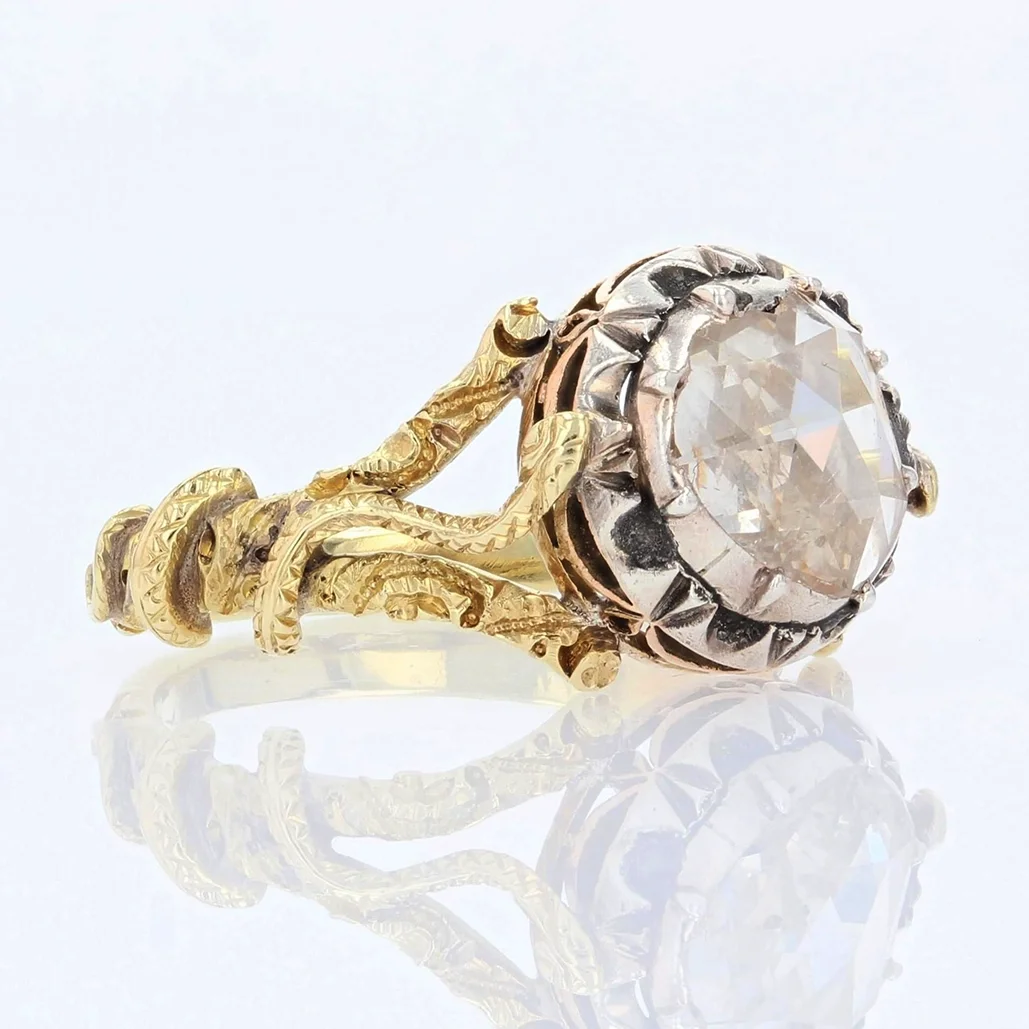
A 19th Century Napoleon III 18-karat yellow-gold ring with a rose-cut diamond. Offered by Baume.
Gemstone Cuts
The gemstone cuts used in antique engagement rings can help you pinpoint the era of an antique ring.
- Table cut: Square with a large, flat top and just a few facets. One of the earliest and rarest cuts.
- Rose cut: Circular with a flat bottom, a domed top and few facets. Frequently used throughout the 1800s
- Step cut: Square or rectangular with long facets that run parallel, resembling stairs. Used from the 1800s to the present.
- Old Mine cut: Rounded square with more facets than the table and rose cuts. Gemstones in rings from the 1800s to the early 1900s often feature this cut.
- Old European cut: Round and faceted shape that’s a precursor to today’s round brilliant cut. Often used in rings through the 1900s.
- Cabochon cut: A rounded top and flat bottom, often used in settings with large opal and turquoise gemstones in the 1900s.
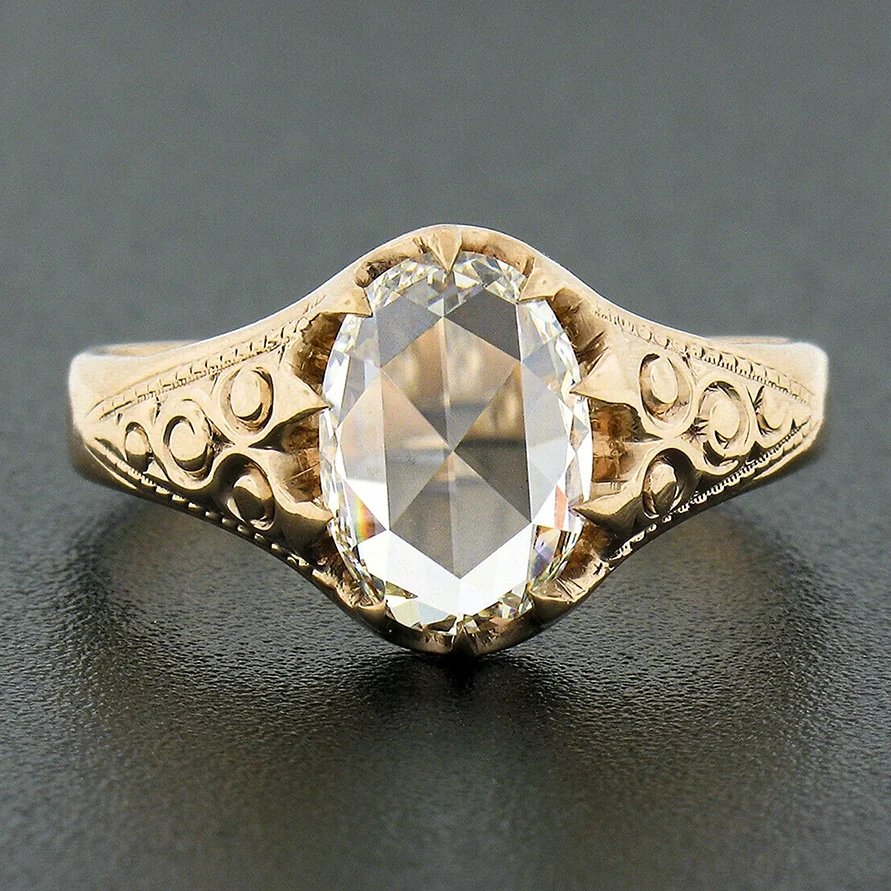
A Victorian 14-karat yellow-gold antique engagement ring featuring a large oval, rose-cut diamond. Offered by Badis Jewelers LLC.
Gemstones
Gemstones have a special place not only in engagement rings but in people’s hearts.
Cherished for their timeless, shimmering beauty and imbued with centuries-old symbolism, gemstones come in a wide range of colors, including unexpected options like a yellow diamond or a pink sapphire. In solitaires or clusters, gemstones add sparkle and convey the vibrant passion of a love story.
- Diamonds are the hardest gemstones and stand out for their extraordinary brilliance. They are usually thought of as being clear, with a dazzling sparkle that turns white light into flashes of color. One in 10,000 diamonds is colored, with hues ranging from yellow and pink to blue and black. The more intense the color, the higher the price of the diamond.
- Sapphires are a traditional gemstone of choice for the engagement rings of royalty. Sapphires conjure up an image of deep, royal blue, but they come in many colors. Whether solo or in combination with diamonds and other precious stones, sapphires are highly prized and sought after.
- Rubies are red and, thanks to their vivid color, easily evoke love. Together with sapphires, rubies form the rare and valuable corundum family, which has the second-hardest gems after diamonds.
- Emeralds stand out in gorgeous greens, from light, springy tones to rich, dark shades. Considered a royal gemstone and beloved by Cleopatra, emeralds have been used in jewelry for centuries. They’re not as hard as diamonds, and the inclusions and fractures visible to the eye make each stone unique.
- Opals come in a range of colors from cream to gray and are known for an optical phenomenon that creates a play of color, reflecting multicolored speckles or flashes of light off the stone's surface. With their low density and sensitivity to sudden changes in temperature, opal engagement rings require a protective bezel setting and a little extra care.
- Pearls, both natural and cultured, can be found in the settings of antique engagement rings. Natural pearls are extremely rare and highly prized, while cultured pearls made this gem more accessible starting in the late 19th century. With a lustrous sheen in hues ranging from white to dark gray, pearls come in all sizes and are a common addition to a cluster setting.
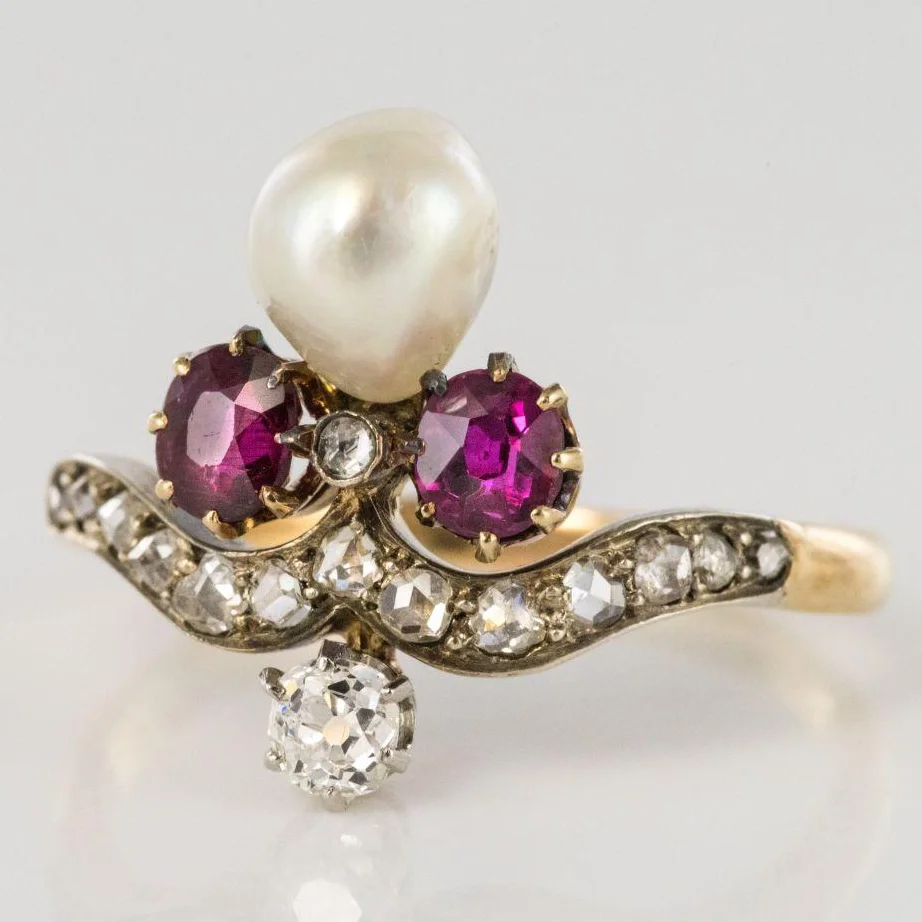
A Napoleon III 18-karat yellow-gold antique engagement ring featuring a natural baroque pearl, two rubies and diamonds adorning the ring band. Offered by Baume.
Hallmarks, Maker's Marks and Engravings
A fascinating part of history can be found on the inside of many antique engagement rings.
The stamps, marks and engravings on the band or shank range from renowned jewelers’ marks and dates to hidden messages and inscribed words of endearment. These marks add authenticity. Some express eternal love in cursive script, as does the 17th-century gold posy ring on display in the British Museum. Its interior text reads, “Two hands one heart, till death us part.” Others are embedded with engraved symbols of devotion, like a heart, clasped hands or even a tiny skull to express the “till death” pledge.
- Antique Georgian rings have no stamps or maker’s marks, since this practice wasn’t common until the 1900s.
- Antique Victorian rings feature a hallmark to indicate metal quality. Many Victorian jewelry houses used maker’s marks or signatures to identify their work.
- Antique Edwardian rings show a hallmark that indicates the metal’s purity and a maker’s mark that identifies the jeweler who created the ring.
- Antique Art Nouveau rings have a hallmark indicating metal quality, often specific to the karat of the metal. Maker’s marks were commonly placed inside the band.
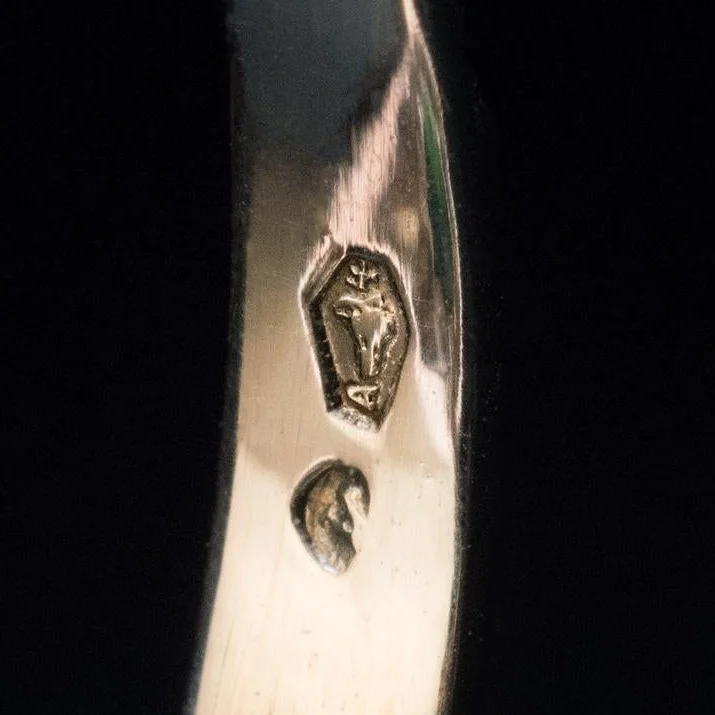
A Victorian 14-karat yellow-gold antique engagement ring stamped with a maker's mark. Offered by Romanov Russia.
An antique Victorian diamond cluster ring. Offered by Heritage Antique Jewellery.
The Allure of Antique Engagement Rings
If you're shopping for an antique engagement ring, consider setting the 4Cs aside. Instead of dedicating yourself to finding the perfect stone, focus on the one that best expresses your special love story. Have faith that the stones in antique engagement rings were hand-cut by jewelers who were masters of their craft.
Antique engagement rings are imbued with individuality, timelessness and a unique charm that matches a one-of-a-kind proposal. From classic gemstones, ancient motifs and unusual settings to the precision and care that define handmade jewelry, antique engagement rings offer everything you need to create a moment, and a lifetime, of impact.
With the vast collection of antique engagement rings on 1stDibs, it’s not easy to pick just one. But no matter which style calls to you or which era you choose, the enduring appeal of a design with a long and storied past is certain. Antique jewelry is a celebration of centuries of romance that will mark the beginning of a new chapter in your own everlasting love story.
